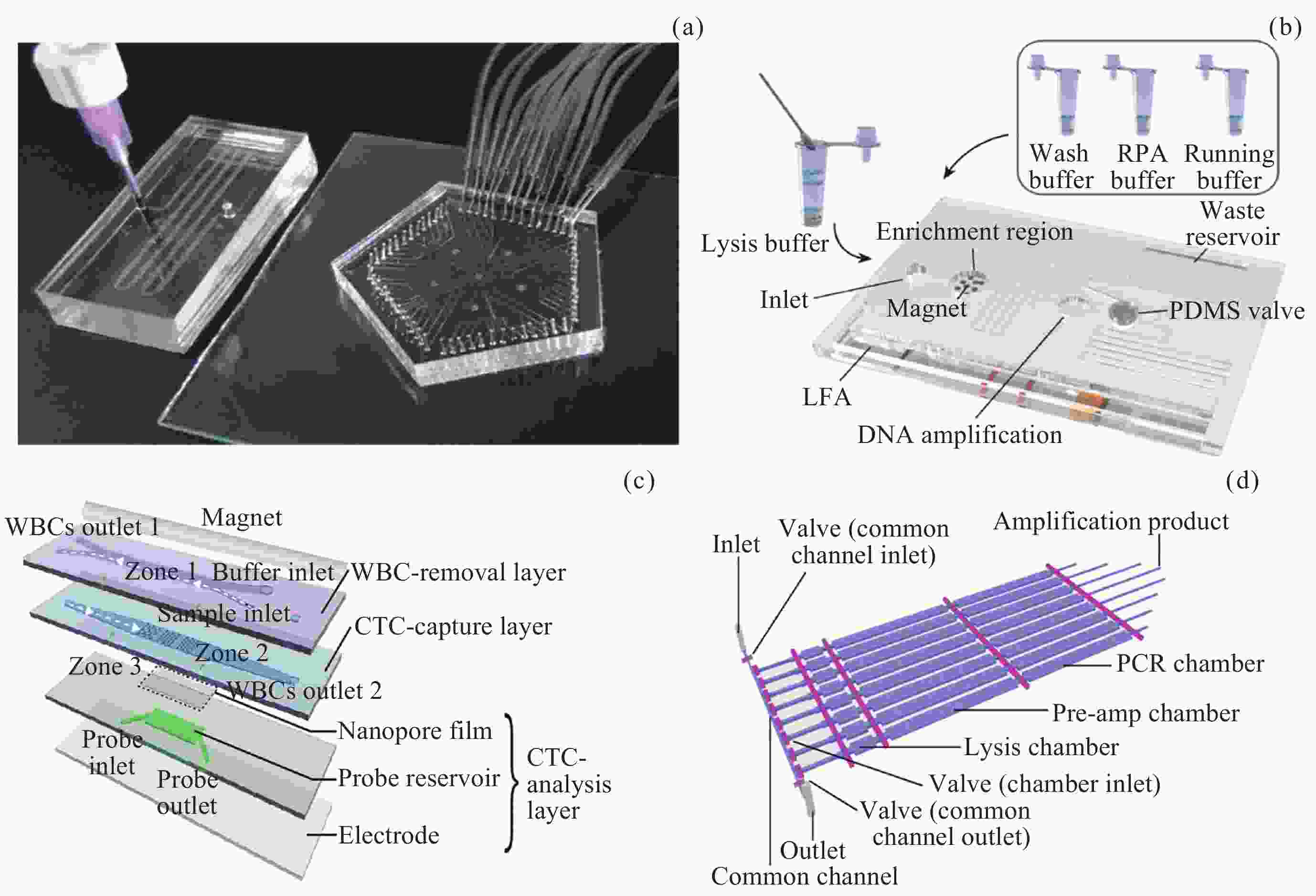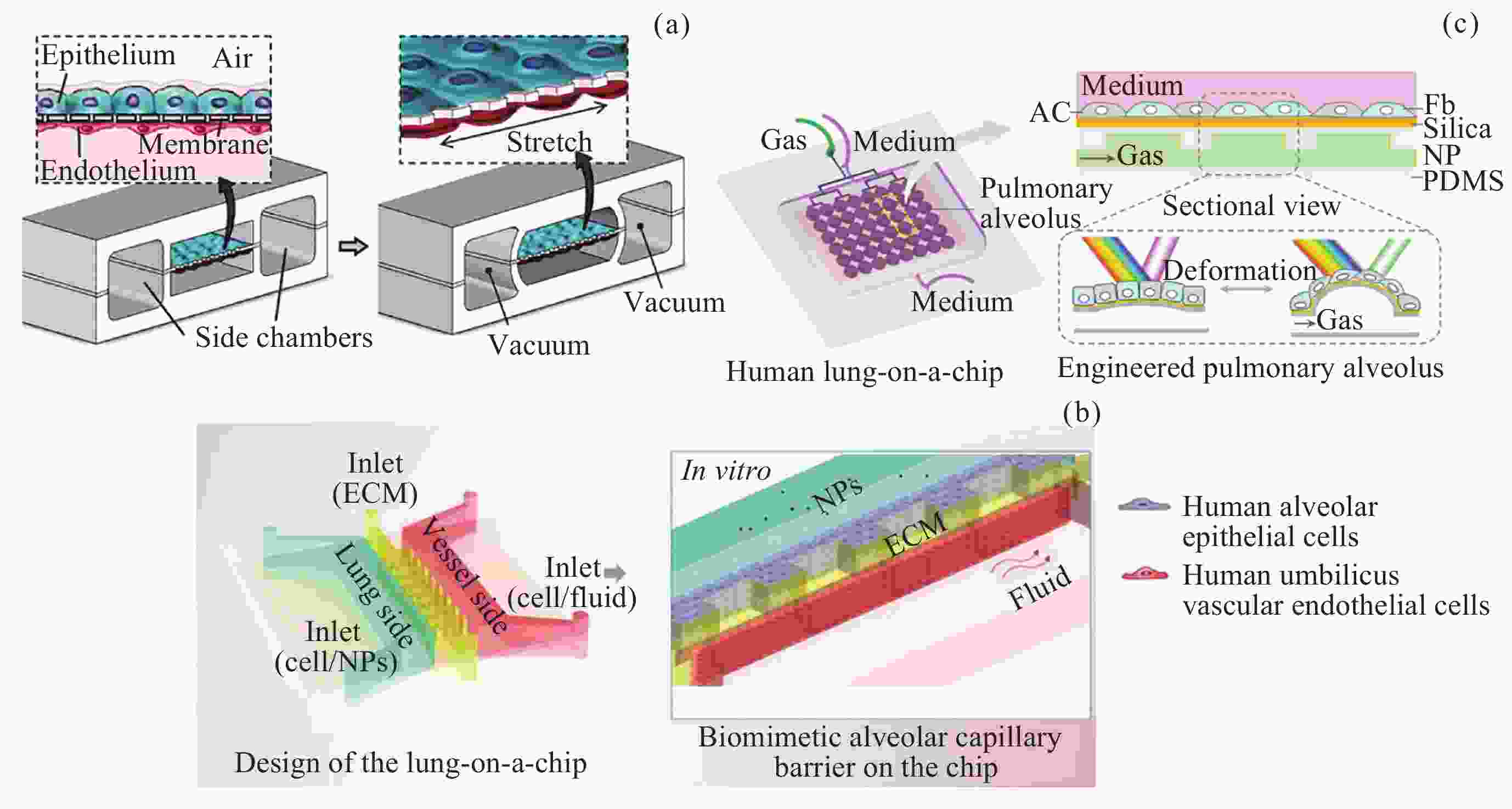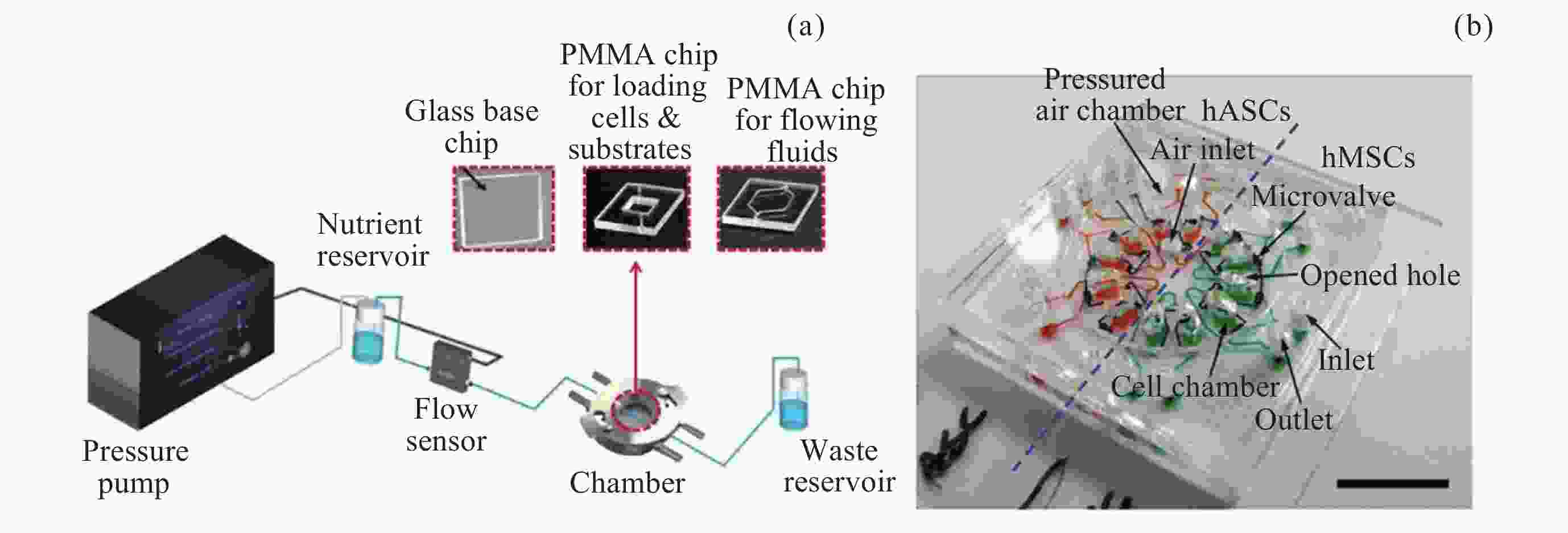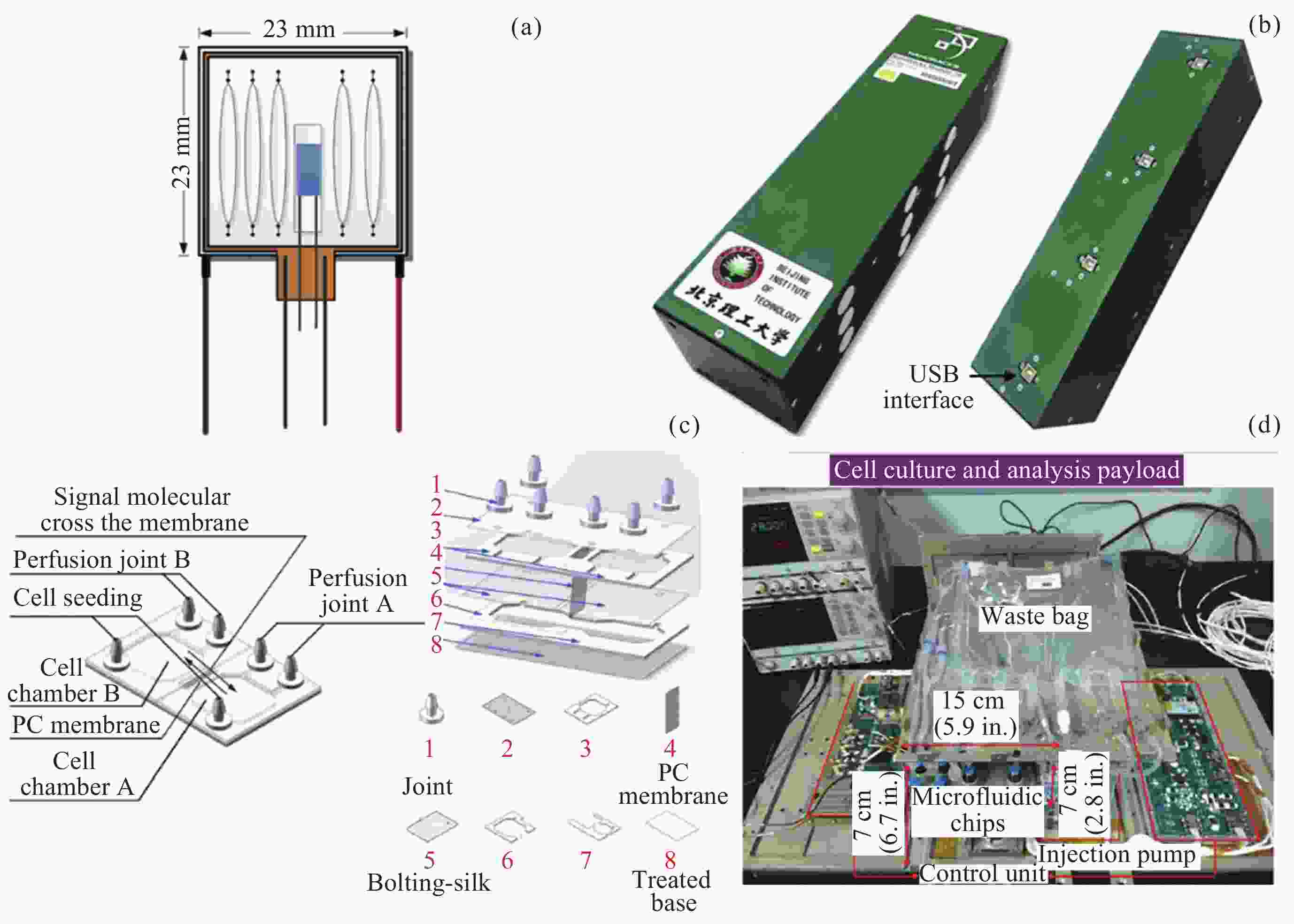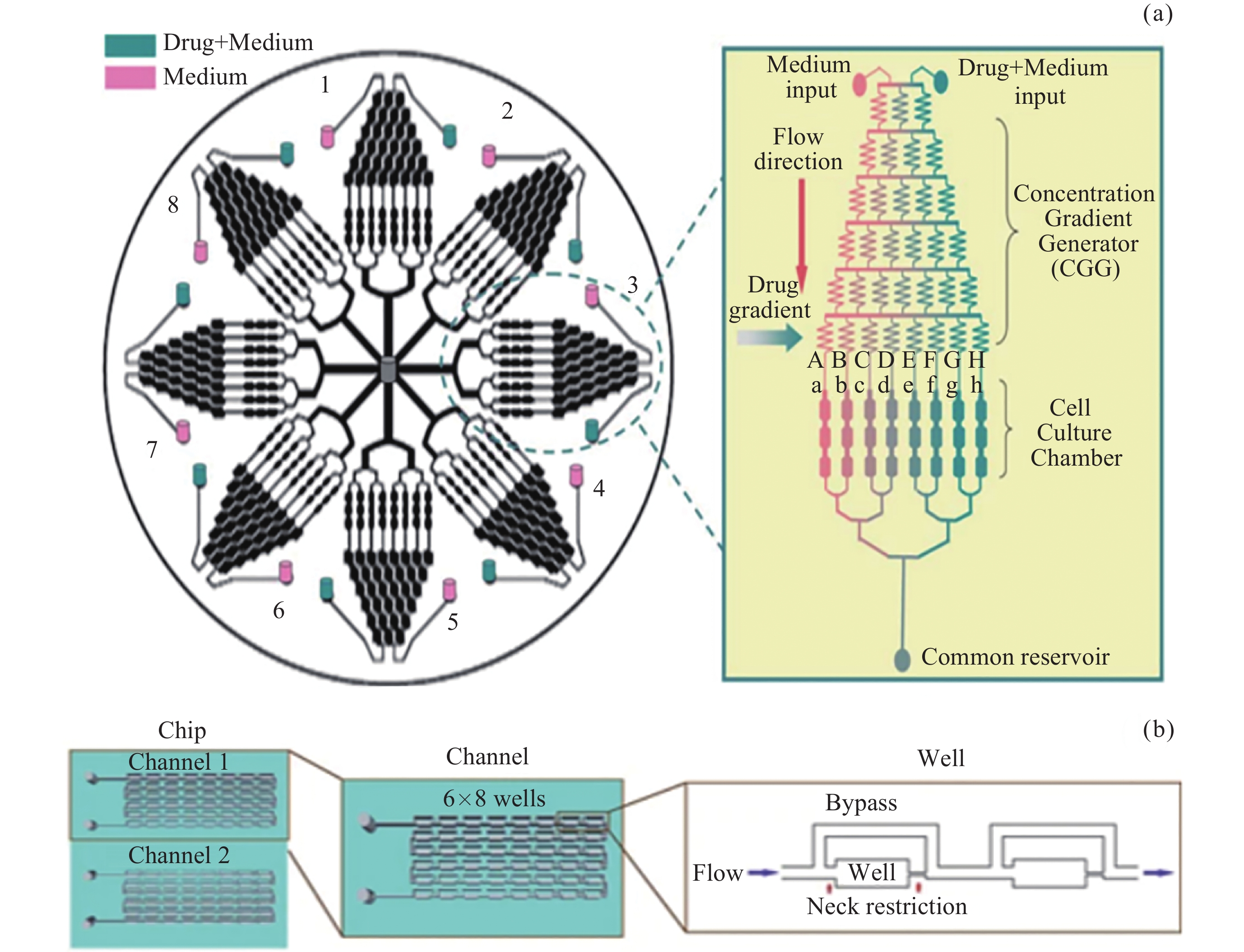Applications of Microfluidic Chips in Space Life Sciences
-
摘要: 微流控芯片(Microfluidic chip)又被称为芯片实验室(Lab-on-a-Chip, LOC), 可在微米尺度对少量液体进行操控, 是近年来新兴的一种可在体外开展生命科学研究的技术, 在药物筛选和体外诊断中具有通量大、灵敏度高的优势, 可用于模拟人体特定器官的复杂微结构、微环境和生理功能. 由于微流控芯片具有体积小、样品用量少、分析时间短、功耗低等特点, 十分适合应用于空间科学实验, 可以有效弥补动物模型在复杂空间环境中的个体差异缺陷, 以及单一细胞模型无法真实模拟体内复杂环境的问题. 本文简介了微流控芯片的发展历程、制作技术及加载方式, 综述了其在地面和空间生命科学方面的应用, 为微流控芯片在空间生命科学研究中的广泛应用提供参考.Abstract: Microfluidic chip, also known as Lab-on-a-Chip (LOC), represent a cutting-edge technology that enables the precise manipulation of small volumes of liquid at the microscale. In recent years, this innovative technology has garnered significant attention for its potential to revolutionize life science research in vitro. Particularly in the fields of drug screening and in vitro diagnostics, microfluidic chips offer remarkable advantages, including high throughput and high sensitivity, allowing for the rapid and accurate analysis of large numbers of samples. Moreover, these chips can be engineered to simulate the complex microstructures, microenvironments, and physiological functions of specific human organs, providing researchers with a powerful tool to study biological processes in a controlled and highly specific manner. Characterized by their compact size, minimal sample consumption, short analysis times, and low power requirements, microfluidic chips are especially well-suited for space science experiments, where resources are often limited and environmental conditions are highly complex. In space research, animal models may exhibit significant individual differences, and single-cell models often fail to accurately simulate the complex in vivo environment. Microfluidic chips effectively address these limitations by offering a more controlled and representative experimental platform. They can simulate the physiological conditions of human organs with greater accuracy and reliability compared to traditional models, making them an invaluable tool for space life science research. This article provides an overview of the development history, fabrication technology, and fluid loading methods of microfluidic chips. It traces the evolution from early concepts to today’s complex devices, discusses various fabrication techniques with their respective advantages and application scenarios, and explores loading techniques that ensure precise fluid control within the chip. Beyond these, the article also highlights the application of microfluidic chips in both terrestrial and space life sciences. From the aspects of drug screening, in vitro diagnostics, and organ-on-a-chip, it focused on how chips can advance life science research. In the context of space research, the article discusses how chips can be utilized to study the effects of microgravity on cell behavior, tissue development, and other biological phenomena. It provides a comprehensive reference for the broader application of microfluidic chips in space life science research.
-
Key words:
- Microfluidic chips /
- Space life sciences /
- Drug screening /
- Organ-on-a-Chip /
- In vitro diagnostics /
- Microgravity
-
图 2 体外检测与诊断芯片. (a)空气细菌捕获富集芯片(左)和免疫分析芯片集成的微流控系统(右); (b)挤压驱动的软管和集成的微流体芯片, 软管分别包含裂解缓冲液、洗涤缓冲液、RPA 缓冲液和电泳缓冲液; (c) NICHE能够去除白细胞、捕获CTC、通过纳米电穿孔技术将探针递送到活的CTC中, 进行细胞内基因的相对定量, 并分析响应免疫细胞的CTC行为以预测免疫治疗反应; (d) 单细胞MALBAC反应的集成微流控装置, 显示流体通道(紫色)和控制通道(洋红色)
Figure 2. In vitro detection and diagnostic chip. (a) Microfluidic system integrated with airborne bacterial capture enrichment chip and immunoassay chip. (b) Squeeze-driven hoses and the integrated microfluidic chip. The hoses contain lysis buffer, wash buffer, RPA buffer, and running buffer respectively. (c) NICHE enables removal of WBCs, capturing CTCs, delivery of DNAT probes into living CTCs through the nanopore-enhanced electrodelivery technique for intracellular mRNA relative quantification, and analysis of CTC behaviors in response to immune cells for immunotherapy response prediction. (d) An integrated microfluidic device designed for single-cell MALBAC reactions, showing fluid channels (purple) and control channels (magenta)
图 5 (a) 芯片实验室便携式检测系统, 由阅读器和拭子系统组成, 用来检测舱内物体表面微生物. (b)远征14/15飞行工程师在空间站上将样本分配到芯片实验室便携式检测系统 (Image courtesy of NASA). (c) 6个Nortis Triplex 芯片集成到KCPP灌注平台. (d) Nortis Triplex芯片. (e)骨骼肌仿生组织芯片
Figure 5. (a) A Lab-on-a-chip portable detection system, consisting of a reader and a swabbing system, is used to detect microorganisms on the surface of objects in the cabin. (b) Expedition 14/15 flight engineer dispense samples to a lab-on-a-chip portable inspection system on the space station (Image courtesy of NASA). (c) Six Nortis Triplex chips are integrated into the KCPP perfusion platform. (d) The Nortis Triplex chip. (e) Skeletal muscle biomimetic tissue chip
-
[1] WHITESIDES G M. The origins and the future of microfluidics[J]. Nature, 2006, 442(7101): 368-373 doi: 10.1038/nature05058 [2] EL-ALI J, SORGER P K, JENSEN K F. Cells on chips[J]. Nature, 2006, 442(7101): 403-411 doi: 10.1038/nature05063 [3] BAISDEN D L, BEVEN G E, CAMPBELL M R, et al. Human health and performance for long-duration spaceflight[J]. Aviation, Space, and Environmental Medicine, 2008, 79(6): 629-635 doi: 10.3357/ASEM.2314.2008 [4] BASNER M, DINGES D F, MOLLICONE D J, et al. Psychological and behavioral changes during confinement in a 520-day simulated interplanetary mission to Mars[J]. PLoS One, 2014, 9(3): e93298 doi: 10.1371/journal.pone.0093298 [5] MATSUSAKI M, CASE C P, AKASHI M. Three-dimensional cell culture technique and pathophysiology[J]. Advanced Drug Delivery Reviews, 2014, 74: 95-103 doi: 10.1016/j.addr.2014.01.003 [6] KRAKOS A. Lab-on-chip technologies for space research-current trends and prospects[J]. Microchimica Acta, 2024, 191(1): 31 doi: 10.1007/s00604-023-06084-4 [7] MANZ A, GRABER N, WIDMER H M. Miniaturized total chemical analysis systems: a novel concept for chemical sensing[J]. Sensors and Actuators B: Chemical, 1990, 1(1/2/3/4/5/6): 244-248 [8] JED HARRISON D, FLURI K, SEILER K, et al. Micromachining a miniaturized capillary electrophoresis-based chemical analysis system on a chip[J]. Science, 1993, 261(5123): 895-897 doi: 10.1126/science.261.5123.895 [9] CHRISTEN J B, ANDREOU A G. Design, fabrication, and testing of a hybrid CMOS/PDMS microsystem for cell culture and incubation[J]. IEEE Transactions on Biomedical Circuits and Systems, 2007, 1(1): 3-18 doi: 10.1109/TBCAS.2007.893189 [10] VAN DEN DRIESCHE S, LUCKLUM F, BUNGE F, et al. 3D printing solutions for microfluidic chip-to-world connections[J]. Micromachines, 2018, 9(2): 71 doi: 10.3390/mi9020071 [11] AU A K, LAI H, UTELA B R, et al. Microvalves and micropumps for BioMEMS[J]. Micromachines, 2011, 2(2): 179-220 doi: 10.3390/mi2020179 [12] 刘林波, 蒋卓, 申旋旋, 等. 微流控系统中微泵和微阀的研究与挑战[J]. 食品与机械, 2024, 40(2): 9-20,27LIU Linbo, JIANG Zhuo, SHEN Xuanxuan, et al. Research and challenges of micropumps and microvalves in microfluidic systems[J]. Food :Times New Roman;">& Machinery, 2024, 40(2): 9-20,27 [13] TIAN C, TU Q, LIU W M, et al. Recent advances in microfluidic technologies for organ-on-a-chip[J]. TrAC Trends in Analytical Chemistry, 2019, 117: 146-156 doi: 10.1016/j.trac.2019.06.005 [14] YOUNG E W K, BEEBE D J. Fundamentals of microfluidic cell culture in controlled microenvironments[J]. Chemical Society Reviews, 2010, 39(3): 1036-1048 doi: 10.1039/b909900j [15] 刘翠, 杨书程, 李民, 等. 药物筛选新技术及其应用进展[J]. 分析测试学报, 2015, 34(11): 1324-1330 doi: 10.3969/j.issn.1004-4957.2015.11.020LIU Cui, YANG Shucheng, LI Min, et al. Drug screening new technologies and their applications[J]. Journal of Instrumental Analysis, 2015, 34(11): 1324-1330 doi: 10.3969/j.issn.1004-4957.2015.11.020 [16] CARD A, CALDWELL C, MIN H, et al. High-throughput biochemical kinase selectivity assays: panel development and screening applications[J]. Journal of Biomolecular Screening, 2009, 14(1): 31-42 doi: 10.1177/1087057108326663 [17] DE SANTIS R, CIAMMARUCONI A, FAGGIONI G, et al. High throughput MLVA-16 typing for Brucella based on the microfluidics technology[J]. BMC Microbiology, 2011, 11(1): 60 doi: 10.1186/1471-2180-11-60 [18] TANG Q Q, LI X Y, LAI C, et al. Fabrication of a hydroxyapatite-PDMS microfluidic chip for bone-related cell culture and drug screening[J]. Bioactive Materials, 2021, 6(1): 169-178 doi: 10.1016/j.bioactmat.2020.07.016 [19] WONG A H H, LI H R, JIA Y W, et al. Drug screening of cancer cell lines and human primary tumors using droplet microfluidics[J]. Scientific Reports, 2017, 7(1): 9109 doi: 10.1038/s41598-017-08831-z [20] LEE M Y, KUMAR R A, SUKUMARAN S M, et al. Three-dimensional cellular microarray for high-throughput toxicology assays[J]. Proceedings of the National Academy of Sciences of the United States of America, 2008, 105(1): 59-63 [21] ENGLERT D L, MANSON M D, JAYARAMAN A. Flow-based microfluidic device for quantifying bacterial chemotaxis in stable, competing gradients[J]. Applied and Environmental Microbiology, 2009, 75(13): 4557-4564 doi: 10.1128/AEM.02952-08 [22] LIU D Y, WANG L H, ZHONG R T, et al. Parallel microfluidic networks for studying cellular response to chemical modulation[J]. Journal of Biotechnology, 2007, 131(3): 286-292 doi: 10.1016/j.jbiotec.2007.06.014 [23] SAADI W, WANG S J, LIN F, et al. A parallel-gradient microfluidic chamber for quantitative analysis of breast cancer cell chemotaxis[J]. Biomedical Microdevices, 2006, 8(2): 109-118 doi: 10.1007/s10544-006-7706-6 [24] YE N N, QIN J H, SHI W W, et al. Cell-based high content screening using an integrated microfluidic device[J]. Lab on a Chip, 2007, 7(12): 1696-1704 doi: 10.1039/b711513j [25] KAMINSKI T S, GARSTECKI P. Controlled droplet microfluidic systems for multistep chemical and biological assays[J]. Chemical Society Reviews, 2017, 46(20): 6210-6226 doi: 10.1039/C5CS00717H [26] 梁怡萧, 潘建章, 方群. 基于微流控技术的细胞水平高通量药物筛选系统的研究进展[J]. 色谱, 2021, 39(6): 567-577 doi: 10.3724/SP.J.1123.2020.07014LIANG Yixiao, PAN Jianzhang, FANG Qun. Research advances of high-throughput cell-based drug screening systems based on microfluidic technique[J]. Chinese Journal of Chromatography, 2021, 39(6): 567-577 doi: 10.3724/SP.J.1123.2020.07014 [27] YANG F, CHEN Z G, PAN J B, et al. An integrated microfluidic array system for evaluating toxicity and teratogenicity of drugs on embryonic zebrafish developmental dynamics[J]. Biomicrofluidics, 2011, 5(2): 24115 doi: 10.1063/1.3605509 [28] 李顺基, 肖育劲, 陈鹏, 等. 微流控芯片技术在体外诊断领域中的应用进展[J]. 分析科学学报, 2020, 36(5): 639-645LI Shunji, XIAO Yujin, CHEN Peng, et al. Current advances in in-vitro diagnostic techniques based on microfluidic chip[J]. Journal of Analytical Science, 2020, 36(5): 639-645 [29] HOSOKAWA M, ASAMI M, NAKAMURA S, et al. Leukocyte counting from a small amount of whole blood using a size-controlled microcavity array[J]. Biotechnology and Bioengineering, 2012, 109(8): 2017-2024 doi: 10.1002/bit.24471 [30] WILDING P, KRICKA L J, CHENG J, et al. Integrated cell isolation and polymerase chain reaction analysis using silicon microfilter chambers[J]. Analytical Biochemistry, 1998, 257(2): 95-100 doi: 10.1006/abio.1997.2530 [31] KIM A S, HOEK E M V. Cake structure in dead-end membrane filtration: monte carlo simulations[J]. Environmental Engineering Science, 2002, 19(6): 373-386 doi: 10.1089/109287502320963373 [32] CHEN X, CUI D F, LIU C C, et al. Microfluidic chip for blood cell separation and collection based on crossflow filtration[J]. Sensors and Actuators B: Chemical, 2008, 130(1): 216-221 doi: 10.1016/j.snb.2007.07.126 [33] LI X, CHEN W Q, LIU G Y, et al. Continuous-flow microfluidic blood cell sorting for unprocessed whole blood using surface-micromachined microfiltration membranes[J]. Lab on a Chip, 2014, 14(14): 2565-2575 doi: 10.1039/C4LC00350K [34] JING W W, ZHAO W, LIU S X, et al. Microfluidic device for efficient airborne bacteria capture and enrichment[J]. Analytical Chemistry, 2013, 85(10): 5255-5262 doi: 10.1021/ac400590c [35] JING W W, JIANG X R, ZHAO W, et al. Microfluidic platform for direct capture and analysis of airborne Mycobacterium tuberculosis[J]. Analytical Chemistry, 2014, 86(12): 5815-5821 doi: 10.1021/ac500578h [36] CHENG Z Y, CHOI N, WANG R, et al. Simultaneous detection of dual prostate specific antigens using surface-enhanced Raman scattering-based immunoassay for accurate diagnosis of prostate cancer[J]. ACS Nano, 2017, 11(5): 4926-4933 doi: 10.1021/acsnano.7b01536 [37] IM H, SHAO H L, PARK Y I, et al. Label-free detection and molecular profiling of exosomes with a nano-plasmonic sensor[J]. Nature Biotechnology, 2014, 32(5): 490-495 doi: 10.1038/nbt.2886 [38] FU Y, WANG N X, YANG A N, et al. Highly sensitive detection of protein biomarkers with organic electrochemical transistors[J]. Advanced Materials, 2017, 29(41): 1703787 doi: 10.1002/adma.201703787 [39] ZEMING K K, SALAFI T, SHIKHA S, et al. Fluorescent label-free quantitative detection of nano-sized bioparticles using a pillar array[J]. Nature Communications, 2018, 9(1): 1254 doi: 10.1038/s41467-018-03596-z [40] KONG X Z, CHENG L, DONG Z Z, et al. Rapid Cryptococcus electroporated-lysis and sensitive detection on a miniaturized platform[J]. Biosensors and Bioelectronics, 2024, 250: 116096 doi: 10.1016/j.bios.2024.116096 [41] WANG Z Y, YAN B, NI Y L, et al. A portable, integrated microfluidics for rapid and sensitive diagnosis of Streptococcus agalactiae in resource-limited environments[J]. Biosensors and Bioelectronics, 2024, 247: 115917 doi: 10.1016/j.bios.2023.115917 [42] DONG Z Z, WANG Y S, XU G L, et al. Genetic and phenotypic profiling of single living circulating tumor cells from patients with microfluidics[J]. Proceedings of the National Academy of Sciences of the United States of America, 2024, 121(19): e2315168121 [43] YU Z L, LU S J, HUANG Y Y. Microfluidic whole genome amplification device for single cell sequencing[J]. Analytical Chemistry, 2014, 86(19): 9386-9390 doi: 10.1021/ac5032176 [44] LI Y Y, LI H, XIE Y P, et al. An integrated strategy for mass spectrometry-based multiomics analysis of single cells[J]. Analytical Chemistry, 2021, 93(42): 14059-14067 doi: 10.1021/acs.analchem.0c05209 [45] BHATIA S N, INGBER D E. Microfluidic organs-on-chips[J]. Nature Biotechnology, 2014, 32(8): 760-772 doi: 10.1038/nbt.2989 [46] VAN DER MEER A D, VAN DEN BERG A. Organs-on-chips: breaking the in vitro impasse[J]. Integrative Biology, 2012, 4(5): 461-470 doi: 10.1039/c2ib00176d [47] INGBER D E. Human organs-on-chips for disease modelling, drug development and personalized medicine[J]. Nature Reviews Genetics, 2022, 23(8): 467-491 doi: 10.1038/s41576-022-00466-9 [48] HUH D, MATTHEWS B D, MAMMOTO A, et al. Reconstituting organ-level lung functions on a chip[J]. Science, 2010, 328(5986): 1662-1668 doi: 10.1126/science.1188302 [49] DAN HUH D. A human breathing lung-on-a-chip[J]. Annals of the American Thoracic Society, 2015, 12(S1): S42-S44 [50] ZHANG M, XU C, JIANG L, et al. A 3D human lung-on-a-chip model for nanotoxicity testing[J]. Toxicology Research, 2018, 7(6): 1048-1060 doi: 10.1039/C8TX00156A [51] ZHU Y J, SUN L Y, WANG Y, et al. A biomimetic human lung-on-a-chip with colorful display of microphysiological breath[J]. Advanced Materials, 2022, 34(13): 2108972 doi: 10.1002/adma.202108972 [52] WITTKOWSKE C, REILLY G C, LACROIX D, et al. In vitro bone cell models: impact of fluid shear stress on bone formation[J]. Front Bioengineering and Biotechnology, 2016, 4: 87 [53] BABALIARI E, PETEKIDIS G, CHATZINIKOLAIDOU M. A precisely flow-controlled microfluidic system for enhanced pre-osteoblastic cell response for bone tissue engineering[J]. Bioengineering (Basel), 2018, 5(3): 66 doi: 10.3390/bioengineering5030066 [54] YANG Y C, HONG Q H, LEI K F, et al. The novel membrane-type micro-system to assess the bonus effect of physiological and physical stimuli on bone regeneration[J]. BioChip Journal, 2021, 15(3): 243-251 doi: 10.1007/s13206-021-00023-2 [55] PARK S H, SIM W Y, MIN B H, et al. Chip-based comparison of the osteogenesis of human bone marrow- and adipose tissue-derived mesenchymal stem cells under mechanical stimulation[J]. PLoS One, 2012, 7(9): e46689 doi: 10.1371/journal.pone.0046689 [56] MAULE J, WAINWRIGHT N, STEELE A, et al. Rapid culture-independent microbial analysis aboard the International Space Station (ISS)[J]. Astrobiology, 2009, 9(8): 759-775 doi: 10.1089/ast.2008.0319 [57] DANILO T. Tissue chips in spaces[EB/OL]. (2020-03-09) [2024-09-25]. https://ncats.nih.gov/tissuechip/projects/space [58] PRZYSTUPSKI D, GÓRSKA A, MICHEL O, et al. Testing Lab-on-a-Chip technology for culturing human melanoma cells under simulated microgravity[J]. Cancers (Basel), 2021, 13(3): 402 doi: 10.3390/cancers13030402 [59] DU J, ZENG L, YU Z T, et al. Magnetic force-based microfluidic chip for plant seed levitation to simulate microgravity environment[C]//34th IEEE International Conference on Micro Electro Mechanical Systems (MEMS). Gainesville, FL, USA: IEEE, 2021 [60] WANG J S, MENG J, DING G G, et al. A novel microfluidic capture and monitoring method for assessing physiological damage of C. elegans under microgravity[J]. Electrophoresis, 2019, 40(6): 922-929 doi: 10.1002/elps.201800461 [61] BANG F B. A bacterial disease of Limulus polyphemus[J]. Bulletin of the Johns Hopkins Hospital, 1956, 98(5): 325-351 [62] MORRIS H C, DAMON M, MAULE J, et al. Rapid culture-independent microbial analysis aboard the International Space Station (ISS) stage two: quantifying three microbial biomarkers[J]. Astrobiology, 2012, 12(9): 830-840 doi: 10.1089/ast.2012.0863 [63] ZHENG W, HSU H, ZHONG M, et al. China's first-phase Mars Exploration Program: Yinghuo-1 orbiter[J]. Planetary and Space Science, 2013, 86: 155-159 doi: 10.1016/j.pss.2011.02.008 [64] SIMS M R, CULLEN D C, RIX C S, et al. Development status of the life marker chip instrument for ExoMars[J]. Planetary and Space Science, 2012, 72(1): 129-137 doi: 10.1016/j.pss.2012.04.007 [65] CHAN E. The Reusable Handheld Electrolyte and Lab Technology for Humans (rHEALTH) sensor[R]. New York: NASA, 2015 [66] JONES-ISAAC K A, LIDBERG K A, YEUNG C K, et al. Development of a kidney microphysiological system hardware platform for microgravity studies[J]. Npj Microgravity, 2024, 10(1): 54 doi: 10.1038/s41526-024-00398-0 [67] LIDBERG K A, JONES-ISAAC K, YANG J D, et al. Modeling cellular responses to serum and vitamin D in microgravity using a human kidney microphysiological system[J]. Npj Microgravity, 2024, 10(1): 75 doi: 10.1038/s41526-024-00415-2 [68] DWIVEDI G, FLAMAN L, ALAYBEYOGLU B, et al. Effects of dexamethasone and IGF-1 on post-traumatic osteoarthritis-like catabolic changes in a human cartilage-bone-synovium microphysiological system in space and ground control tissues on earth[J]. Frontiers in Space Technologies, 2024, 5: 1358412 doi: 10.3389/frspt.2024.1358412 [69] GIZA S, MOJICA-SANTIAGO J A, PARAFATI M, et al. Microphysiological system for studying contractile differences in young, active, and old, sedentary adult derived skeletal muscle cells[J]. Aging Cell, 2022, 21(7): e13650 doi: 10.1111/acel.13650 [70] DI FILIPPO E S, CHIAPPALUPI S, FALONE S, et al. The MyoGravity project to study real microgravity effects on human muscle precursor cells and tissue[J]. Npj Microgravity, 2024, 10(1): 92 doi: 10.1038/s41526-024-00432-1 [71] PARAFATI M, GIZA S, SHENOY T S, et al. Human skeletal muscle tissue chip autonomous payload reveals changes in fiber type and metabolic gene expression due to spaceflight[J]. NPJ Microgravity, 2023, 9(1): 77 doi: 10.1038/s41526-023-00322-y [72] SCHREPFER S. Microgravity as model for immunological senescence and its impact on tissue stem cells and regeneration[DB/OL]. (2017-06-15) [2024-09-25]. https://reporter.nih.gov /project-details/9403001 [73] WORTHEN G S. Lung host defense in microgravity[DB/OL]. (2017-06-15) [2024-09-25]. https://reporter.nih.gov/project-details/9403062 [74] HINOJOSA C D. Organs-on-chips as a platform for studying effects of microgravity on human physiology: Blood-brain barrier-chip in health and disease[DB/OL]. (2017-07-15) [2024-09-25]. https://reporter.nih.gov/project-details/9402972 [75] HINOJOSA C D. Organ-chips as a platform for studying effects of space on human enteric physiology: interactions of epithelial mucosa with sensory neurons and microbiome[DB/OL]. (2018-09-20) [2024-09-25]. https://reporter.nih.gov/project-details/9645490 [76] LOW L A, GIULIANOTTI M A. Tissue chips in space: modeling human diseases in microgravity[J]. Pharmaceutical Research, 2020, 37(1): 8 doi: 10.1007/s11095-019-2742-0 [77] HUGHSON R L, HELM A, DURANTE M. Heart in space: effect of the extraterrestrial environment on the cardiovascular system[J]. Nature Reviews Cardiology, 2018, 15(3): 167-180 doi: 10.1038/nrcardio.2017.157 [78] WU J C. Effect of microgravity on drug responses using engineered heart tissues[DB/OL]. (2018-09-20) [2024-09-25]. https://reporter.nih.gov/project-details/9644885 [79] LAFLAMME M A, MURRY C E. Heart regeneration[J]. Nature, 2011, 473(7347): 326-335 doi: 10.1038/nature10147 [80] KIM D H. A human iPSC-based 3D microphysiological system for modeling cardiac dysfunction in microgravity[DB/OL]. (2018-09-20) [2024-09-25]. https://reporter.nih.gov/project-details/9644709 [81] 赵莹莹, 李勤, 葛洋, 等. 微流控芯片在血液检验中的应用及航天医学应用前景分析[J]. 航天医学与医学工程, 2012, 25(4): 307-312ZHAO Yingying, LI Qin, GE Yang, et al. Application of microfluidic chip in blood analysis and its prospects in space medicine[J]. Space Medicine :Times New Roman;">& Medical Engineering, 2012, 25(4): 307-312 [82] YANG C H, DENG Y L, REN H, et al. A multi-channel polymerase chain reaction lab-on-a-chip and its application in spaceflight experiment for the study of gene mutation[J]. Acta Astronautica, 2020, 166: 590-598 doi: 10.1016/j.actaastro.2018.11.049 [83] CHEN Y, PEI S Z, YAN L B, et al. Design and surface modification of a microfluidic chip for intercellular interactions research during space flight[J]. Acta Astronautica, 2020, 166: 619-627 doi: 10.1016/j.actaastro.2019.02.002 [84] LI Y R, LV X F, GENG L N, et al. A chip-based scientific payload technology for visual detection of proteins and its application in spaceflight[J]. Acta Astronautica, 2020, 170: 601-608 doi: 10.1016/j.actaastro.2020.02.037 [85] YANG Q Q, ZHONG R T, CHANG W B, et al. WormSpace μ-TAS enabling automated on-chip multi-strain culturing and multi-function imaging of Caenorhabditis elegans at the single-worm level on the China Space Station[J]. Lab on a Chip, 2024, 24(14): 3388-3402 doi: 10.1039/D4LC00210E [86] WANG L, CHEN Z Z, XU Z Y, et al. A new approach of using organ-on-a-chip and fluid-structure interaction modeling to investigate biomechanical characteristics in tissue-engineered blood vessels[J]. Frontiers in Physiology, 2023, 14: 1210826 doi: 10.3389/fphys.2023.1210826 -
-





 魏栋苹 女, 2000年3月出生于山西省大同市, 现就读于北京航空航天大学生物与医学工程学院, 硕士研究生. 研究方向为航天生物医学工程, 空间生命科学. E-mail:
魏栋苹 女, 2000年3月出生于山西省大同市, 现就读于北京航空航天大学生物与医学工程学院, 硕士研究生. 研究方向为航天生物医学工程, 空间生命科学. E-mail: 
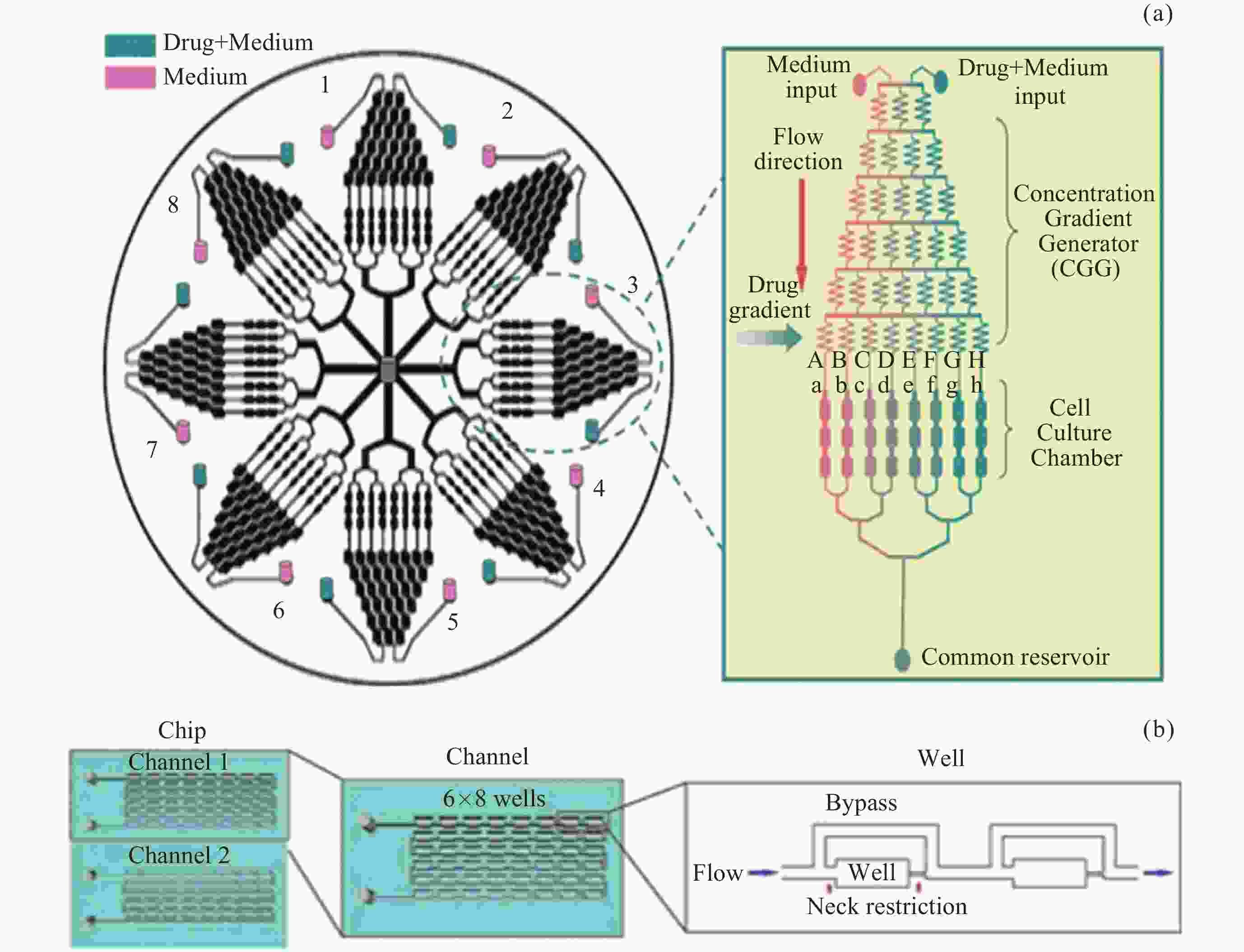
 下载:
下载:
